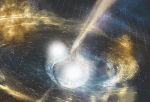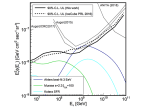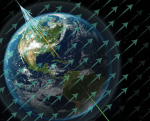The IceCube, LIGO, Virgo, and ANTARES collaborations have used data from the first observing period of Advanced LIGO and from the two neutrino detectors to search for coincident neutrino and gravitational wave emission from transient sources. Scientists did not find any significant coincidence. The results, recently submitted to The Astrophysical Journal, set a constraint on the density of these sources. […]
Research
The Sun also casts a shadow on IceCube
The IceCube Collaboration has measured the Sun’s cosmic-ray shadow for the first time, from data covering a period of five years. The results, submitted today to The Astrophysical Journal, show a clear but different shadow pattern every year. When looking at the yearly variation, scientists have found that the shadow pattern follows changes in the solar activity, which we know are correlated with the strength of the Sun’s magnetic field. Thus, this study opens a new line of research for the Antarctic neutrino observatory: the study of the Sun’s magnetic field using IceCube cosmic-ray data. […]
The hardest search yet: cosmogenic neutrinos wait for next generation detectors
The IceCube Collaboration has, once more, looked for extremely high-energy neutrinos. And now, after analyzing nine years of IceCube data, scientists set the most stringent limits on the existence of cosmogenic neutrinos to date. As a result, the idea that ultra-high-energy cosmic rays are mostly protons is vanishing. These results were published in the journal Physical Review D last week. […]
Understanding inelasticity in high-energy neutrino interactions with IceCube
The IceCube Collaboration has recently presented its first measurements of the neutrino inelasticity, which are also the first-ever at very high energies—from 1 TeV up to nearly 800 TeV. The inelasticity distribution was found to be in good agreement with Standard Model prediction and was later used to perform other measurements, such as charm production in neutrino interactions or flavor composition of astrophysical neutrinos. […]
Constraints on neutrino emission from short-lived transient sources
In a new search for neutrino sources, the IceCube Collaboration and other collaborators have looked for short-lived transient sources, including gamma-ray bursts, core-collapse supernovae, or neutron star mergers. The search, which looked for two or more neutrinos detected within 100 seconds from the same location, included transients that might not emit gamma rays and might be pointing to uncharted objects in the universe. The results submitted this week to Physical Review Letters did not identify any individual source but did show that the number of bright short-lived transient neutrino sources must be small or they must be fairly faint. […]
IceCube neutrinos pass a test of a fundamental symmetry in nature
A new measurement of the IceCube Collaboration has put Lorentz symmetry to the test and found—yet again—that neutrinos behave as expected. The results, published in Nature Physics, are the most stringent limits to date in the neutrino sector on the existence of a Lorentz violating field. […]
IceCube neutrinos point to long-sought cosmic ray accelerator
Observations made by the IceCube Neutrino Observatory at the Amundsen–Scott South Pole Station and confirmed by telescopes around the globe and in Earth’s orbit have for the first time provided evidence for a known blazar as a source of high-energy neutrinos. These results are presented in two papers published this week in the journal Science. […]
Heavy dark matter and PeV neutrinos: are they related?
The IceCube Collaboration has tested a few models of heavy dark matter and found no evidence that the high-energy neutrinos can be attributed to the decay of dark matter particles. This nondetection resulted in a new lower limit for the lifetime of dark matter particles with a mass of 10 TeV or above. The paper summarizing these results has just been submitted to the European Physical Journal C. […]
The 2018 IceCube Masterclass: engaging students around the world with IceCube scientists
The fifth edition of the IceCube Masterclass hosted over 300 students at 17 institutions in Belgium, Denmark, Germany, Switzerland, and the United States. […]
A boost to precision measurements in the neutrino sector
With better and larger neutrino telescopes on the horizon, researchers are now designing more efficient analysis techniques that will boost our understanding of neutrinos and advance searches for new physics, including additional neutrino flavors or new interactions. These techniques not only provide more accurate and robust results but also reduce expenses and time in computation that could limit improvements in the design of new detectors or the discovery potential of existing facilities. Details of these new techniques are given in a paper by the IceCube-Gen2 Collaboration submitted this week to Computer Physics Communications. […]









